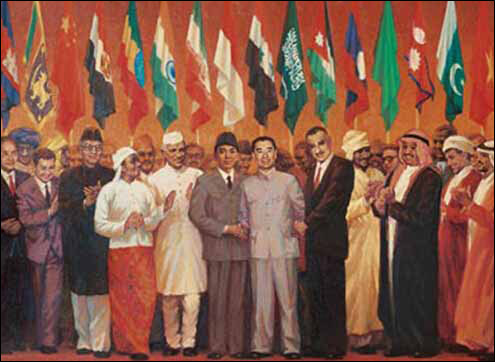‘One Belt, One Road’ initiative lauded for enriching the ‘Bandung spirit’

Scholars have hailed the “One Belt, One Road” initiative, or Silk Road Economic Belt and 21st Century Maritime Silk Road, for carrying forward the “Bandung spirit” at a symposium held from April 13 to 14 in Lianyungang, Jiangsu Province, to commemorate the 60th anniversary of the Bandung Conference.
The Asian-African Conference, also known as the Bandung Conference, was convened in 1955 in Bandung, Indonesia. At the conference, representatives from Asian and African countries collectively expressed their dissatisfaction with the unfair and unreasonable international order, while laying out a vision for a new type of international relations.
“The ‘Bandung spirit’ can be summarized as a call for a peaceful coexistence among the nations, for the liberation from the hegemony of any superpower and for building solidarities towards the weak and those being weakened by the world order of the day,” according to a statement on bandungspirit.org, an online portal affiliated with the conference.
Liu Guijin, president of the China Asia-Africa Society (CAAS), said that the “Bandung spirit” still has modern significance, noting it is vital to settle all disputes based on solidarity, cooperation and peaceful means.
Having endured tremendous change over the past 60 years, countries in Asia and Africa now face new opportunities and challenges. Participating scholars claimed that the implementation of the “One Belt, One Road” initiative and founding of the Asia Infrastructure Investment Bank (AIIB) have presented important historical opportunities for Asia-Africa cooperation and development of the two continents.
Gao Xiang, secretary-general of the Chinese Academy of Social Sciences (CASS), defined the “One Belt, One Road” initiative as a vivid manifestation of major-country diplomacy with Chinese characteristics.
As key continents for China to carry out major-country diplomacy with Chinese characteristics, Asia and Africa will undoubtedly provide valuable ideological resources for the country to enrich its unique diplomatic mode, said Gao.
In return, as the second largest economy in the world, China has performed its responsibilities as a great power to deepen and expand Asia-Africa cooperation through the “One Belt, One Road” initiative, therefore enhancing interconnectivity and promoting the development of many countries in Asia and Africa, Liu said.
So far, more than 60 economies and international organizations linked to the strategy have supported its implementation. Similarly, the AIIB has also attracted support worldwide with more than 50 countries applying as founding members.
Scholars said that the two strategic initiatives will bring hope to Asia, Africa and the world in establishing a new type of international order.
In the new era, Asia and Africa are tasked with achieving common development. The fundamental way to achieve this is to seek and find their own path, said Wang Lincong, research fellow from the Institute of West-Asian and African Studies (IWAAS) at CASS.
By making use of China’s advantages and tapping its development experience, the “One Belt, One Road” initiative will help Asian and African countries explore their own development path and adapt to globalization. Moreover, it is not confined to Asia-Africa cooperation, but stressing cooperation aimed at mutual benefit on a global level, Wang Lincong said.
As a public product China offers to the world, the “One Belt, One Road” initiative, though first raised by China, is by no means a “solo” venture. Rather it is an open and cooperative “chorus” of the world that includes Asian and African countries, said Chinese Special Envoy for Middle East Wang Shijie.
The “One Belt, One Road” initiative is different from other strategies previously proposed by other countries, Liu said. It emphasizes principles of joint consultation, joint building and sharing. China will never impose its ideas or priorities on its neighbors or other countries concerned, said Liu. Before the initiative was put forward, China had clearly outlined it to related countries to align the initiative with regional development strategies and priorities, thereby realizing common development.
Attended by more than 70 officials and scholars, the symposium was hosted by the CAAS, IWAAS, Middle East Studies Association in China and Lianyungang municipal government.
Zhang Chunhai, Hou Li are reporters at the Chinese Social Sciences Today.
